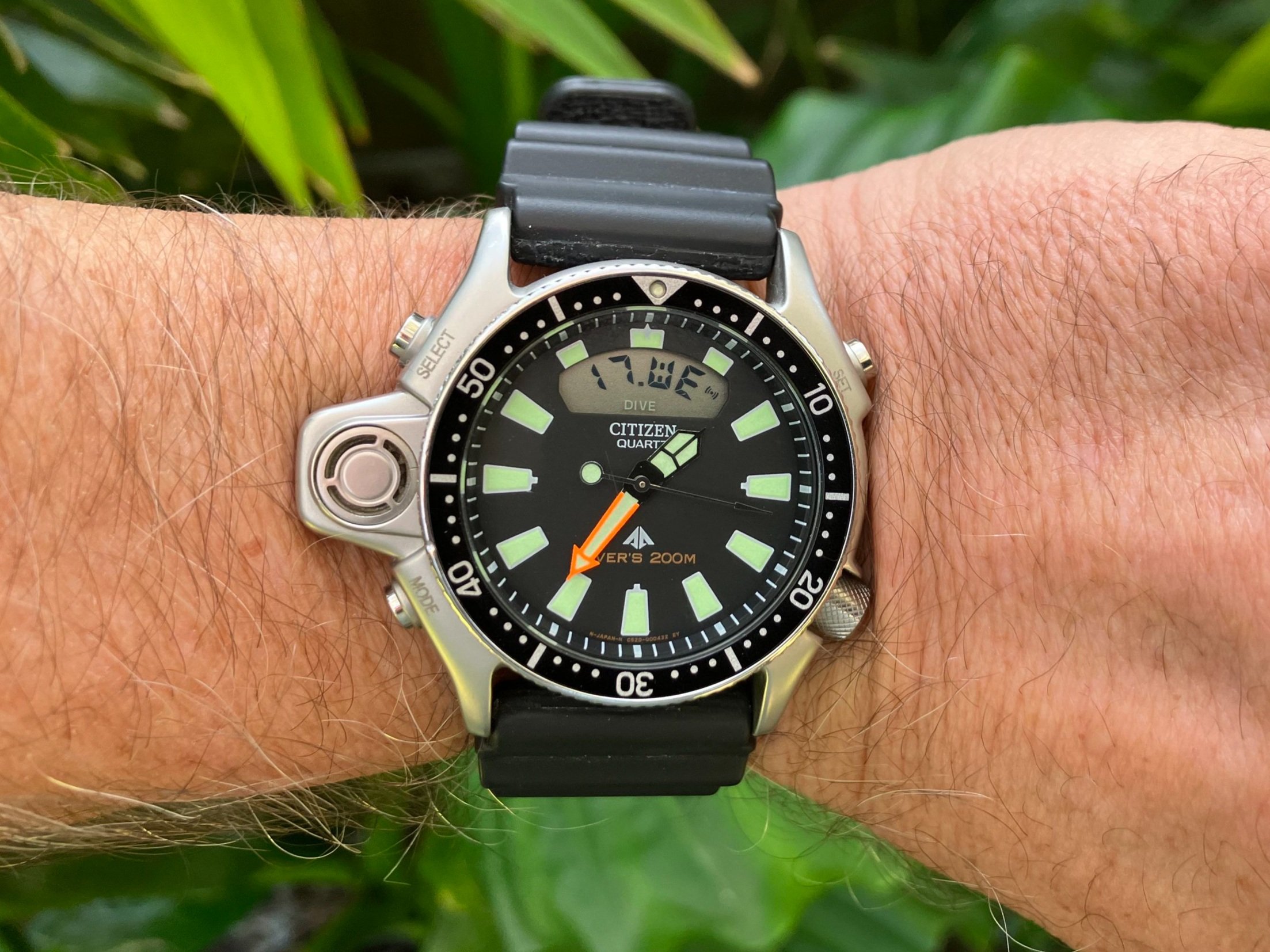Le Grand Bleu – the Citizen Promaster Aqualand JP2000
On the wrist. The Citizen Promaster Aqualand JP2000-08e. Photo: Matthew Smeal
I used to think the Citizen JP2000 was the ugliest watch in dive watch history. But over time, I came to admire its unique beauty. Today, I think it’s stunning.
Back in 2020, I bought two Citizen Promaster Aqualand dive watches as a 50th birthday present to myself: a JP1010 (the most recent version of the Aqualand Duplex issued to Royal Australian Navy Clearance Divers) and the JP2000 – the first dive watch to incorporate a dive computer and what has become a dive watch classic. Both had been discontinued but I found a new one of each and scooped them up before they disappeared for good. They are the only quartz watches I own, and the only Citizens.
The JP1010 was nowhere near as cool as I wanted it to be: the bezel sucks, the skeletal hands are impossible to read—especially underwater through goggles—the auto dive sensor (which automatically switches the watch into dive mode on contact with water) is hyper sensitive and also switches the watch into dive mode on contact with sweat, heat, humidity, sunlight, darkness, dirt, air, sight, thought, gamma rays, UV light, passing cars.... This is a known problem (I know now) but with so much time in dive mode, the battery, which had been in the watch for goodness knows how long, needed replacing after a solid month. Seventeen months later, it needed another one.
I finally got around to booking it in with Citizen's service department, but the automatic response I got after submitting the online form told me that Citizen is apparently out of parts (it's a battery!) so can't help me. They did offer me 50 per cent off something from their online store though. I thought something was amiss so filled out the form again and re-submitted it. I got the same response (and offer! Do I now get 100 per cent off a new watch?). I rang them. A recorded message told me they can't answer the phone due to staff shortages. WTAF?
Brothers in arms – almost. The Citizen Promaster Aqualand JP1010 and the JP2000. Photo: Matthew Smeal
The JP1010 is slowly making its way from my bedside table to desk, to dining room table, to draw, as I work out what, if anything, I’m going to do with it. Meanwhile, my JP2000 just keeps ticking. It still has the battery it came with more than two years ago—despite having had more wrist time, alarm time, and ocean time than the JP1010. The bezel is the work of tool watch utility perfection. The minute hand is glorious in its safety orange glow. Dive mode is up to me: just push and hold the mode button. No danger of it cutting in and draining the battery. And, it automatically switches back to time mode when it hasn’t been in the water for a certain period of time.
The JP2000 is everything you want in a dive watch, especially one that may be used for what so few dive watch wearers do—diving. The dive data and features offer a level of safety and redundancy that, while revolutionary back in the 80s, is still darn useful today – at least as a back-up to a modern dive computer.
Whichever way you look at it, the JP2000 screams ‘I live, work, and play in the ocean’. It is a serious dive watch for serious people. Just ask the Frømandskorpset – the Danish combat frogman corps. The JP2000 was their dive watch choice for years.
See something familiar? A Citizen JP2000 on the wrist of a Danish combat frogman – the Frømandskorpset. Photo: Soldaten
Citizen made a few model variations of the JP2000 and its early incarnation, the CO23: all stainless, two-tone (stainless with gold accents), and a black PVD-coated titanium version with gold accents. But the biggest tweak was internal, moving from the three batteries and a six-screw case back of the original CO23 model in 1985, to the single battery and screw-down case back of the JP2000 a few years later. The watch was discontinued in the late 90s but thankfully new old stock (NOS)—like mine—still pop up occasionally. [NB: I am now seeing the JP2000 listed on Citizen sites, including a blue dial version. Has the JP2000 been re-released? It would make sense; Citizen got it right the first time.]
The watch gained some level of notoriety after being worn by Enzo Molinari (played by Jean Reno) in Luc Besson’s cinema classic The Big Blue (Le Grand Bleu). The black versions—as worn by Reno—are now lovingly referred to in watch geek circles as the Citizen 'Enzo'. [BTW, Enzo Maiorca—of whom the Enzo Molinari character was based—wore Squale, as did the real-life Jacques Mayol, the film’s main character. I just thought I should mention that, being a Squale wearer and all. Please see my review and thoughts about the Squale 50 Atmos 1521 here.]
Jean Reno as Enzo Molinari in Luc Besson’s Le Grand Bleu (The Big Blue) wearing a Citizen CO26 or CO27. Photo: Framerated
If you want to pick yourself up a bit of dive watch coolness and history—not to mention a highly functional tool watch—the Citizen Promaster Aqualand JP2000 is a great place to start.
For more information, Hodinkee did a great personal review of the JP2000 here:
https://www.hodinkee.com/articles/citizen-aqualand-birth-of-a-legend-end-of-an-era
As did Horbiter:
https://www.horbiter.com/en/citizen-promaster-aqualand-jp2000-8e-review-price/



